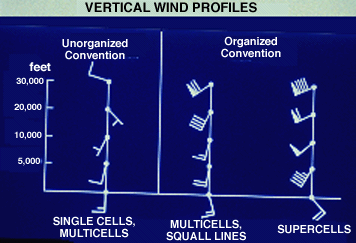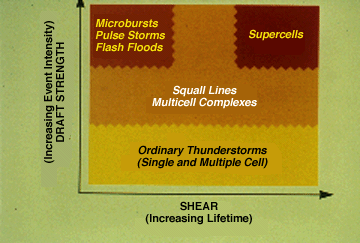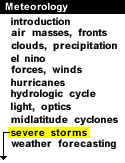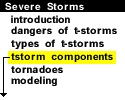
|
For convenience, we refer to storms in unsheared and sheared environments as unorganized and organized convection, respectively. Organized storms are longer-lived, usually have preferred areas of new updraft development, and often allow for some predictability of periodic severe weather events. Unorganized storms appear to be more chaotic, because of their nature and, to some extent, because of our lack of knowledge about them.

The examples of vertical wind profiles are similar to those that have been observed with different storm types: from the chaotic, light winds of unorganized summer storms, to the veering and increasing winds typical of organized storms. Although wind profiles of multicells and supercells appear to be similar, note both the stronger 5 to 10 thousand foot level winds and the greater low-level directional turning with supercells. These are causative factors of supercell updraft rotation. We must caution that vertical wind profiles are subject to rapid space and time changes, and better observation systems such as profilers will be important in improving practical storm-type forecasting. Also, these specific wind profiles are not the only arrangements that can occur with the different storm types. For instance, supercell surface winds may be easterly, with 5,000 foot winds southerly, and so on.

This diagram summarizes the combined effects of draft strength and vertical shear strength on storm type. Weak shears typically lead to short life cycles, although some severe weather can occur when instabilities and draft strengths are great (upper left). Stronger shears lead to longer storm life cycles, and repeated severe episodes. Note that supercells combine the strongest shears with the greatest instabilities. It is important to know that storm-relative winds are critical rather than absolute winds. Therefore, one must figure storm motion into the complex relationships concerning thunderstorm and vertical wind shear interactions.
We may think of this diagram as another form of the thunderstorm spectrum. In this case, the effects of ambient atmospheric dynamics and thermodynamics on storm type are included. The information in the diagram is subjective, and we cannot assign absolute shear and stability values as partitions between storm types. Instead, we must think of the boundary and near-boundary areas as the domains of hybrid thunderstorms.

introduction |
|

Outflow Phenomena |




